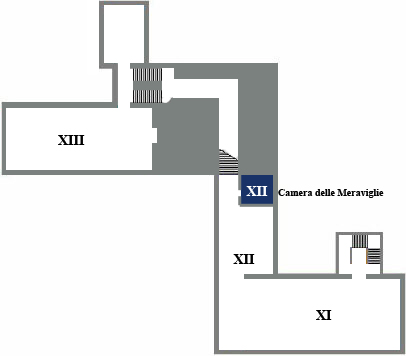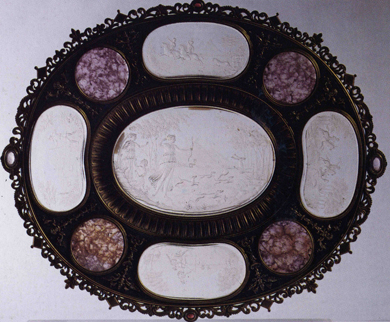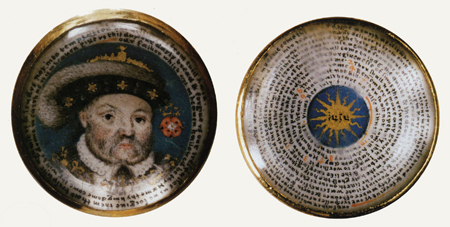|

From halfway through the 16th century special rooms were created in the courts, especially those of central Europe, and were known by the German term of Wunderkammer, i.e. Chambers of Marvels. In these, naturalia, fragments of stone, exotic shells and precious perfumes, were exhibited alongside artificialia, manmade objects of strange shapes and types.
In this context, nature was seen as an inexhaustible quarry of surprising products. It was up to Man to amplify the marvel of Nature itself by working the most unusual stone, the most variegated shell, or an ostrich egg, creating objects with precise functions.
The Chamber of Marvels of the museum contains such curiosa et pretiosa.
|
|
Nuremberg
Chalice
17th century
The chalice produced in Nuremberg in the 17th century consists of a cup made from an ostrich egg supported by a tall, richly-worked silver pedestal.
The egg, sliced off horizontally at about three-quarters of its height, is etched and blackened to represent two episodes in the story of the judgement of Solomon.
The pedestal, which is an extraordinary piece of silver work, terminates at the top in a series of curled ribbons; the knop halfway up the stem is worked as a nest inhabited by animals; the double-edged rounded base is decorated with vegetable motifs and scrolls. This typical object of Wunderkammer taste has links with Northern Renaissance production, which is celebrated for its original and virtuoso silver work.
|
|
Milan
Boat-shaped vase
mid- 16th century
This two-handled boat-shaped vase is carved out of six blocks of rock crystal, a precious form of quartz which is so hard as to require grinding with diamond powder. A symbol of frozen time, rock crystal was painstakingly carved and etched into refined objects, composed with other semi-precious stones, and mounted on extraordinary 16th-and 17th-century gold and silver supports. The body of this boat-shaped vase, carved out of a single piece of stone, is decorated with vegetable motifs. Two gaping theatre masks form the lips, the high scroll-shaped handles are decorated with tendrils, the oval base is decorated with stylised pod motifs like the lid. The vase, which is further embellished with some enamelled gold applications and the finial of the lid, can be traced to Milanese production of the second half of the 16th century.
|
|
Milan
Tray
mid-16th century
The oval tray in gold-plated chiselled silver is made up of five oval rock crystal plaques alternating with four amethyst medallions.
The crystal plaques, which are etched with great virtuosity to depict hunting scenes, show points of contact with works made in the Milanese workshops which were active during the second half of the 16th century. The tray can perhaps be attributed to the well-known workshop of the Sarachi family, skilful gold-and silver-smiths and engravers of semi-precious stones.

|
|
England
Pair of rings with miniatures
c. 1622
The two rings with smooth bands each have a circular plaque setting to which a miniature on paper has been applied then protected by a small piece of rounded glass. These rings, which are examples of the most painstaking virtuoso craftsmanship, both bear micro-inscriptions in English: the Lord's Prayer, the Creed and the Ten Commandments on one and the portrait of Henry VIIIth surrounded by the text of the Lord's Prayer on the other.
The two miniatures belong to the time of James Ist (1556-1625) when authorisation to translate the Bible had just been granted, and they are dated to 1622.

|
|